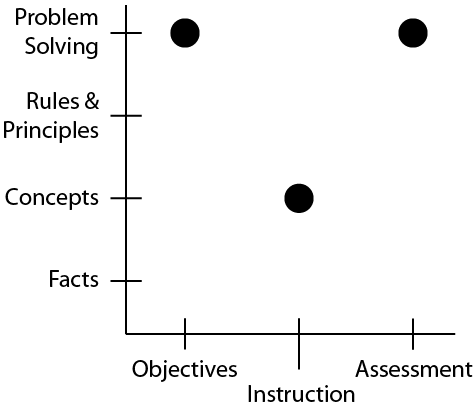Alignment of Objectives, Instruction, and Assessment
Your learning objectives, lesson content and activities, and assessments should all align with each other. In other words, you should strive to match your assessments for a given lesson to the lesson objectives, whether those objectives are cognitive, affective, or psychomotor.
Examples of Mismatched and Matched Objectives, Instruction and Assessment
The graphic below shows a mismatch of the objectives, instruction and assessment for an example lesson. In this case:
- Objectives for the lesson are related to problem-solving.
- During instruction, only lower level concepts are presented to students.
- The students are assessed on their problem-solving abilities.
Because the level of instruction is misaligned with the objectives and the assessment in this example, students will not have the opportunity to practice at the appropriate level, and they are more likely to struggle with problem-solving assignments or problem-solving questions on an exam.

In contrast, the graphic below shows an example of matching objectives, instruction, and assessment.
- Objectives for the lesson are related to problem-solving.
- Content and learning activities are focused on demonstrating and practicing problem-solving.
- The students are assessed on their problem-solving abilities.

Aligning Questions with Bloom's Taxonomy of Cognitive Objectives
In higher education, most learning objectives, lesson content and activities, and assessment fall into the cognitive domain, and Benjamin Bloom's Taxonomy of Cognitive Objectives is the most common model for writing cognitive objectives. You can also use Bloom's taxonomy to help align your assessment questions with your objectives.
Bloom first created his taxonomy in the 1950's and it was revised in 2001. From simple cognitive tasks to complex ones it works as follows:
- Remember - Using memory to recall facts and definitions.
- Understand - Constructing meaning from information.
- Apply - Using procedures to carry out a task.
- Analyze - Breaking materials into parts to determine structures and relationships.
- Evaluate - Making judgments based on checking against given criteria.
- Create - Putting materials together to form a unique product. Problem solving.

You can use Bloom's taxonomy to assist you in aligning your objectives, instruction, and assessment.
Verbs for Cognitive Objectives
The perfect time to think about your assessments is while you are writing your objectives. Incorporating key verbs from the table below into your objectives is one way to forecast the types of assessment you will use to measure students’ achievement of those objectives.
| Remember | Understand | Apply | Analyze | Evaluate | Create |
|---|---|---|---|---|---|
|
Define Identify List Name Recall Recognize Record Relate Repeat Underline Circle |
Cite examples of Demonstrate use of Describe Determine Differentiate between Discriminate Discuss Explain Express Give in own words Identify Interpret Locate Pick Report Restate Review Recognize Select Tell Translate Respond Practice Simulates |
Apply Demonstrate Dramatize Employ Generalize Illustrate Interpret Operate Operationalize Practice Relate Schedule Shop Use Utilize Initiate |
Analyze Appraise Calculate Categorize Compare Conclude Contrast Correlate Criticize Deduce Debate Detect Determine Develop Diagram Differentiate Distinguish Draw conclusions Estimate Examine Experiment Identify Infer Inspect Inventory Predict Relate Solve Test Diagnose |
Appraise Assess Choose Compare Critique Estimate Evaluate Judge Measure Rate Score Select Validate Value Test |
Arrange Assemble Collect Compose Construct Create Design Develop Formulate Manage Modify Organize Plan Prepare Produce Propose Predict Reconstruct Set-up Synthesize Systematize Devise |
Examples of Questions for Each Level in Bloom's Taxonomy
Remember
- Who? What? Where? When? How?
- Describe: User types answer here..
- What is User types answer here.?
Understand
- In your own words, re-tell User types answer here..
- What is the main idea of User types answer here.?
- What differences exist between User types answer here. and User types answer here.?
- Write a brief outline.
Apply
- How is User types answer here. an example of User types answer here.?
- How is User types answer here. related to User types answer here.?
- Why is User types answer here. significant?
- Describe an example of when User types answer here. happens.
Analyze
- What are the parts of User types answer here.?
- Classify this according to User types answer here..
- Create an outline/concept map of User types answer here..
- Provide evidence that User types answer here. is correct.
Evaluate
- Compare and contrast User types answer here. to User types answer here..
- Select the best product.
- Critique the play.
- Judge the following in these merits: User types answer here..
Create
- Organize the following: User types answer here..
- Predict what will happen next.
- What solutions would you suggest for User types answer here.?
- How would you design a new User types answer here.?
Additional Links
- Major Categories in the Taxonomy of Learning Objectives Retrieved January 17, 2020.
- Bloom's Taxonomy of the Cognitive Domain Retrieved January 17, 2020.
- Learning Objective Verbs for Specific Disciplines Retrieved January 17, 2020.
Offline References
Anderson, L.W., & Krathwohl (Eds.). (2001). A Taxonomy for Learning, Teaching, and Assessing: A Revision of Bloom's Taxonomy of Educational Objectives. New York: Longman.
Bloom, B.S. and Krathwohl, D. R. (1956). Taxonomy of Educational Objectives: The Classification of Educational Goals, by a committee of college and university examiners. Handbook I: Cognitive Domain. NY, NY: Longmans, Green.